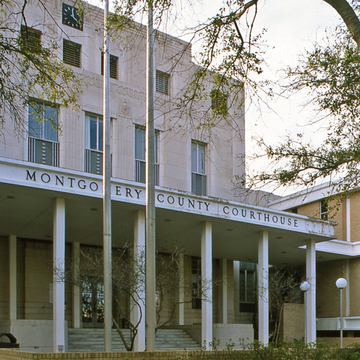The county courthouse, designed by Houston architect Finger, is a monumental four-story modernistic block faced with limestone and decorative aluminum spandrels. Unfortunately, two-story wings added in 1965 totally consume the square's open space. Moreover, they sit over a partially exposed basement-level parking garage, which crowds the edges of the square. Even so, downtown Conroe has been architecturally, if not commercially, revitalized. The perimeter of the square is virtually intact and it is marked by the dark red brick that, as much as the change in topography and tree species, announces the transition from the Gulf Coastal Plain to east Texas. An intensive rehabilitation effort begun in 1999 makes the point that in the chaotic suburban sprawl of Montgomery County, there is a “there” here, to counter Gertrude Stein's observation about her hometown, Oakland, California.
You are here
Montgomery County Courthouse
If SAH Archipedia has been useful to you, please consider supporting it.
SAH Archipedia tells the story of the United States through its buildings, landscapes, and cities. This freely available resource empowers the public with authoritative knowledge that deepens their understanding and appreciation of the built environment. But the Society of Architectural Historians, which created SAH Archipedia with University of Virginia Press, needs your support to maintain the high-caliber research, writing, photography, cartography, editing, design, and programming that make SAH Archipedia a trusted online resource available to all who value the history of place, heritage tourism, and learning.















